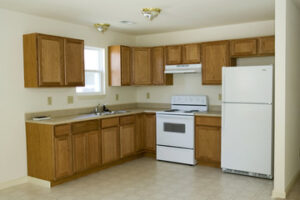While Painting Inside Of Cabinets are personal decisions, many homeowners choose to do it to add a fresh look. For a durable finish that can hold up to everyday wear and tear, an alkyd-based paint is the best choice.

Begin by removing doors and drawers from their hinges. Place the hardware in labeled bags to make reattaching them easier.
Cabinet painting is a fairly easy and inexpensive way to give your kitchen a makeover. Most home improvement magazines, books and websites offer a lot of basic how-to tips. But what they fail to tell you is that proper surface preparation is the key to a successful cabinet paint job, inside and out. If you skip the prep work, you may be left with flaking or peeling paint, and if that happens, you’ll have to strip everything down to bare wood and start from scratch.
Before starting the actual painting process, clear out all contents of your cabinets. Usually, you don’t have to empty the drawers and cupboards, but if they are filled with food or cans of whatever, move them to a safe place where they won’t get in the way of your project. If you have to remove the hardware from the cabinets, make sure that you label each door and drawer so that you know where they go when it’s time to reinstall them.
Next, wash the cabinet surfaces and wipe them down with a degreasing cleaner such as trisodium phosphate (TSP) or a sponge. Be sure to scrub all corners and crevices. Rinse and dry all surfaces thoroughly. If your cabinets have a shiny finish, use 220-grit sandpaper to roughen the surface for better adhesion of the new primer and paint. Wipe down all surfaces again to remove any dust or residue.
It is also a good idea to cover your countertops, backsplash and floors with drop cloths or tarps to protect them from spills, drips and overspray. Using fans and keeping the windows open will keep the air moving, which will help the paint dry faster. Check the back of the can for the maximum recoat time; this is the amount of time that it will take for the paint to cure.
Once the first coat of primer is applied and has dried, apply a second coat. It’s important to let the second coat dry completely before applying the final topcoat, as this will help ensure a consistent and even color.
Primer
Whether your cabinets are wood or laminate, it’s best to prime them before you paint. This ensures that the new coat of paint adheres to the cabinet surface. Primer is also a great way to hide any minor blemishes and imperfections, making your final product look flawless. Before applying primer, scuff sand the cabinets to remove any sheen and create a smooth base for painting.
There are several types of primers available for kitchen cabinets, including oil-based, shellac-based, and water-based. Each has its own pros and cons. Oil-based primers provide a better seal and stain blocking properties, but emit strong fumes that require protective equipment and long drying times. Shellac-based primers are low in VOCs and dry quickly, but may not be as durable as latex or oil. Water-based primers are easy to work with and clean up easily, but they may not provide as good of an adhesion as oil-based primers.
If you are working with old or damaged cabinets, consider using a stain-blocking primer. These are particularly effective on cabinets with nicotine stains, water damage, or other severe discolorations. They are a great choice for anyone who wants their cabinet finish to last a long time.
Adhesion primers are ideal for slick surfaces like laminate or glossy paint, because they help to create a bond between the cabinet surface and new paint. They are usually a little more expensive than other types of primer, but can save you money in the long run by protecting your cabinets from peeling and chipping.
When choosing a primer for your cabinets, keep in mind that some products can take up to 16 hours to dry. To speed up the process, use fans and open windows to keep the air moving. Once your cabinets are ready, apply a second even coat of ADVANCE interior paint with a roller on flat surfaces and a brush for hard-to-reach areas. Wait at least overnight for the second coat to dry, and then sand with 220-grit sandpaper before finishing. This allows the finish to cure completely and prevents the topcoat from peeling or flaking prematurely.
Paint
Cabinet paint is specially formulated to stand up to the wear and tear of everyday use. It’s thicker than wall paint, providing extra protection against chipping and peeling. It also contains special adhesives that help it adhere to cabinet surfaces, which are often more slick than walls and can make it hard for regular wall paint to grip. Cabinet paints are available in a wide range of colors, and they’re designed to hide imperfections in the wood grain.
It’s important to select a high-quality cabinet paint for your project, as it will be exposed to more wear and tear than other surfaces in your home. Cabinets are often used for food prep, and they’re also subject to heat and moisture. The best cabinet paints will hold up to these conditions, and they’ll look beautiful for years to come.
If you’re not comfortable doing your own painting, or if you have a big project on your hands, consider hiring a professional. This will ensure that your cabinets are painted properly, and it will save you time and hassle. However, it’s important to do your homework before you hire a contractor. Look for a company with an excellent reputation and plenty of experience in the field.
When choosing a color for your cabinet doors, it’s recommended to opt for a satin or eggshell finish. This type of finish will be less noticeable than a glossy finish, and it will also be more forgiving when it comes to scuffs and fingerprints.
Before you start painting, it’s important to thoroughly clean your cabinets with a degreaser like TSP to remove grease and cooking residue from the surface. Then, sand the surface of your cabinets with a medium 300-400 grit sandpaper to smooth it out and create a clean canvas for your new coat of paint. After sanding, wipe down all surfaces with a damp cloth or lint-free tack cloth to remove any dust or debris.
It’s recommended to apply 2-3 coats of paint when painting cabinets. Allow each coat to dry fully between applications. It’s also important to follow the manufacturer’s instructions for drying times. Once the cabinets are dry, you can reinstall them and enjoy your newly painted kitchen!
Finish
Now that the cabinet interior has been lightly sanded, and you’ve applied your primer, it is time to apply your finish coat. Again, I suggest you use a high-quality acrylic latex paint for the best results. If you are sensitive to the stinky fumes from oil-based paint, consider using a water-based acrylic.
A good quality latex product will give you a smooth, durable finish that will stand up well to wear and tear. It will also hold up well to moisture and cleaning products. Use a velour roller for easy application to flat surfaces, and switch to a brush in the nooks and crannies. Make sure you have good air flow in your work area during this process, and keep the windows open.
There are many paint options for cabinets, from traditional oil-based paint to newer hybrid alkyds. Oil-based paints have a strong binder that makes them the hardiest choice for high touch areas, but they are difficult to clean and release volatile organic compounds (VOCs), which are not healthy for your kitchen. Water-based alkyd paints have become more common, and these are much easier to clean up, and they don’t release VOCs as quickly as oil paints.
For a durable, washable finish, I recommend you use a semi-gloss or gloss paint. It will be more durable than eggshell or flat paint and will hold up better against scuff marks.
After you have rolled the last of your ADVANCE interior paint onto the cabinet boxes and doors, let it dry thoroughly. This is an important step that can’t be rushed. Depending on the humidity, this can take 24 hours or more.
When the paint is dry, you can put back your drawers and shelves. I recommend waiting at least 8 hours before you start placing things back in your cabinetry, to allow the paint to fully cure.
It’s a good idea to label your cabinet doors and drawers before you remove them from the cabinet boxes, so you know where everything goes when it is time to put them back. It is also a good idea to use a damp cloth to wipe down the cabinets before you place them back in, just to make sure that they are clean and free of any residue or dirt.

